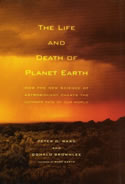
I never thought a book about astrobiology could be depressing, but when I put down The Life and Death of Planet Earth by Peter D. Ward and Donald Brownlee, I couldn’t help but feel kind of glum.
Over the course of nearly 300 pages, Ward and Brownlee take a look at our planet and its inhabitants. They chart the Earth’s formation, the catastrophic events that shaped its history, and the rise of life, and finally the evolution of higher life forms. This is familiar territory that they covered in more depth in their previous book, Rare Earth. If you stopped reading here, it would be a happy book.
But there’s lots more to read. They then go on to predict what the future holds for our planet. Whether it will end in fire or ice? Apparently both… and worse. In case you didn’t know, we’re probably enjoying a warm siesta between severe ice ages. And while there are cold times ahead they will eventually end. Our Sun is steadily increasing in temperature – and as the temperatures rise, the biologic diversity on Earth will shrink (it’s possible that we’ve already gone past the height of life’s diversity and we’re already on the slide down). Eventually higher life forms won’t be able to survive, then the plants will go, and finally, hardy heat-loving bacteria living in the highest mountains at the Poles will be driven to extinction and the Earth will be a lifeless, dead world. Then the Sun will enter the final stages of its life, balloon out past the orbit of the Earth, and consume our planet in a fiery afterthought.
Like I said, depressing. But don’t worry, we’ve got a few hundred million years left to enjoy our planet before we’re driven off it as a species.
Ward and Brownlee tell an engaging story, and I was pretty hooked from beginning to end. There’s lots of scientific terminology, but it’s always well explained – easy reading for almost anyone. At each point they stop to describe our future world, they step away from the science and just tell you what you’d see if you looked around. It was very easy to imagine what it must be like to stand on a sun-parched landscape and see our descendants struggling to survive.
The Life and Death of Planet Earth isn’t without hope, though. There are plans afoot to change the Earth’s orbit by engineering near misses by asteroids – hopefully this could set our planet on an outward spiral that always keeps us in the right distance to enjoy a temperate environment. They encourage ongoing research into space exploration as a way to avoid our ultimate fate.
I’m hoping Ward and Brownlee will continue on this path for another book, and maybe paint a portrait of how the Universe will end. After all the galaxies have drifted apart; after all the stars have decayed and turned into white dwarfs or black holes; after black holes have consumed all the matter there is; and after the black holes themselves have evaporated, leaving us with a Universe of elementary particles accelerating away from each other into the darkness.
Have a nice day. 🙂
